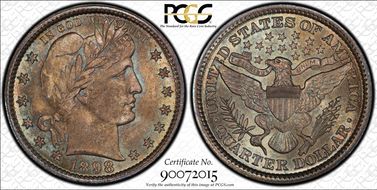H. D. Redford (7/29/1898-1/6/1974) 的钱币相册
1898-O 10C MS64, pop. (15/14), (3/13). Regardless of the mintage, which exceeded 2 million coins, this date is elusive and highly desirable in any Mint State grade. The present specimen has frosty silver luster with light tan surfaces framed by deeper iridescent toning near the borders.
1898-S 10C MS65, pop. (5/6), (3/13). The 1898-S Barber dime is another rare series issue in Mint State. This piece is fully detailed with speckled crimson , amber, and blue highlights on the obverse, the reverse is a mottled russet and jade-green. A single contact mark below the M in DIME rules out an even finer designation. This boldly struck piece is highly elusive in Gem or better grade. Population: 5 in 65, 6 finer. (9/09)
1898-O 25C MS63, pop. 12/25, (3/13). Needed this coin to regain #1 ranking with PCGS. It replaces a VF30 that I bought just to fill the space until I could find a suitable replacement. This coin is the second offered by Heritage in as many weeks. The first I was outbid on and was about to give up hope of finding one to fit my budget when this came available for roughly $1,000 less than my bid on the other coin. Nearly 2 million (1,868,000) 1898-O quarters were minted for circulation, resulting in a low Mint State population today. Few collectors sought these coins at the time of issue, so high-grade survival was strictly a matter of chance. This pleasing Select Mint State piece is fully lustrous with satiny silver surfaces beneath delicate gold toning on each side. The strike is bold and the eye appeal is outstanding.
1898-S 50C MS63 Pop. (5/21) (3/13). I paid a premium for this coin. The devices on the reverse have a golden patina as if an artist took a very fine brush and painted them. Absolutely gorgeous! I doubt if there is a 63 out there that looks as good as this one. PCGS: 6/20, NGC: 3/17; 12/29/2009.
1898 $2.50 MS64 Pop. (144/114) (3/13). The 1898 quarter eagle (mintage 24,000) can be found in most grades up to gem uncirculated. PCGS: 129/107, NGC: 143/163; 12/29/2009.
1898 $5 MS63 Pop. (130/52) (3/13). Thanks to a relatively high mintage (633,420), the 1898 half eagle is very common in most grades. Choice MS-64 coins are quite scarce and very few have been graded at the gem level. The Smithsonian lacks a circulation strike example of the 1898 half eagle.
1898-S $5 MS63 Pop. (68/41) (3/13). The 1898-S half eagle sports a mintage (1,397,400) more than twice it's Philadelphia counterpart although it is seen much less frequently. This issue becomes quite scarce in choice condition. The finest known example is from the Eliasberg collection which was sold in 1982.
1898 $10 MS64 Pop. (64/10) (3/13). Bought this coin as an NGC MS63 and resubmitted to PCGS where it was upgraded to a MS64. All I really wanted was a crossover...boy was I surprised! Despite its high mintage (812,130) the 1898 eagle is nowhere near as common as one would think. Apparently far fewer of this date were shipped to Europe or they are waiting to be discovered. The collector will have no difficulty finding Mint State examples up to MS-62. Choice examples become scarce and MS-64 and better become very rare. Two NGC MS-67 examples are the finest known, with the possibility they are the same coin. PCGS: 52/6, NGC: 92/35; 10/3/2009.
1898-S $10 MS63 Pop. (34/9) (3/13). This eagle with a mintage of 473,600 was used extensively in international commerce and is hard to come by in anything greater than MS-61. Choice examples are scarce and gem examples are exceedingly rare. PCGS: 28/8, NGC: 33/14; 10/3/2009.
1898 $20 MS62 Pop. (532/162) (3/13). The mintage (170,395) for the 1898 double eagle is dramatically lower than for the other Philadelphia issues of the previous few years. The result is an issue that is much scarcer and seldom seen above MS-62. An MS-64 sold for $12,650 in 2005.
1898-S $20 MS64+ Pop. (30/97) (3/13). The 1898-S double eagle was struck in very large numbers (2,575,175) and is plentiful in most grades. A PCGS 67 example sold at auction in 2004 for $44,875.






































